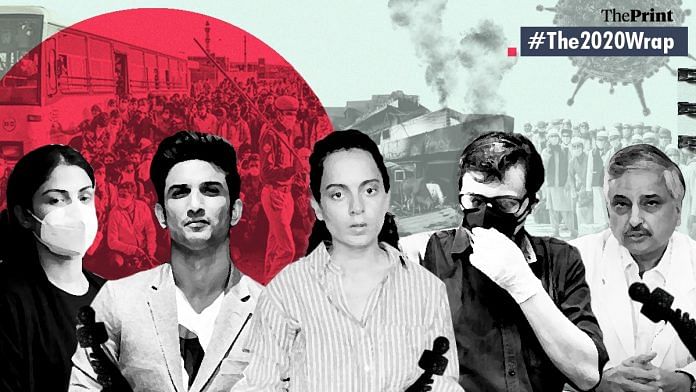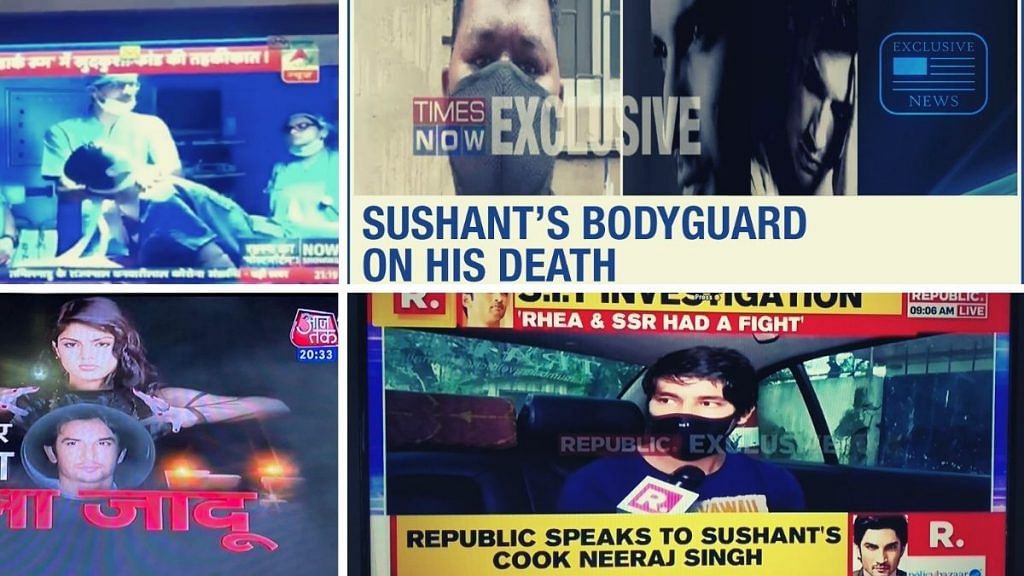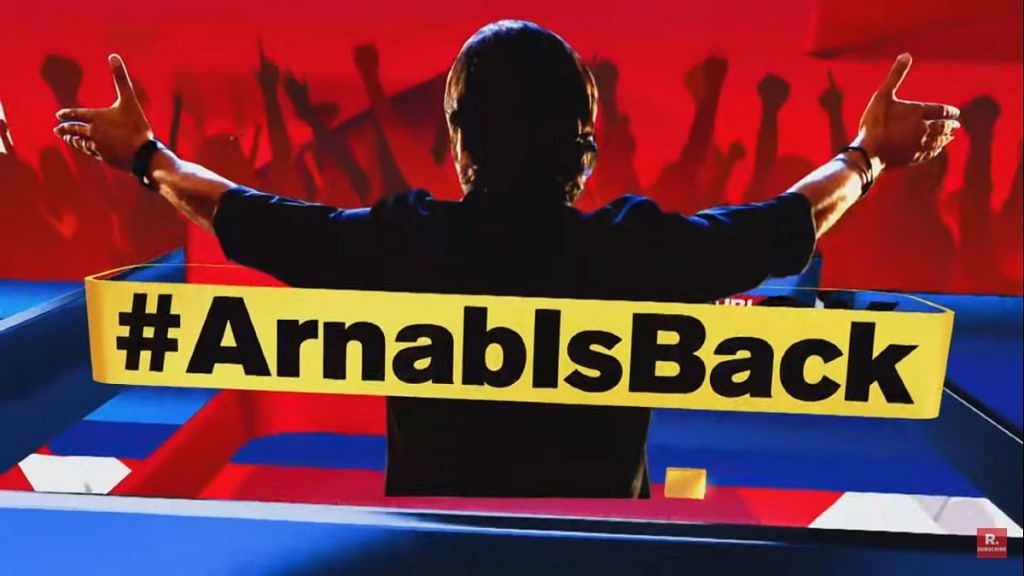
This was the year of a spiked, furry orange tennis ball, hurtling around the Earth with increasing speed and venom, month upon month.
The coronavirus has owned the news since February, in a way perhaps no event has since World War II: not a day passed without the latest infection tally, death toll, or hunt for a vaccine bossing the headlines.
But it can happen only in India that the death of an actor elbowed out what has been arguably the story of a lifetime — a pandemic that has infected more than 80 million worldwide — to become the defining newsmaker of the year.
2020 will be remembered as the year the news (almost) died, at the hands of news channels. Worse, it was the year TV anchors became the message instead of the messengers.
On the cusp of 2021, a few suggestions on how to revive the media.
Don’t turn news into entertainment
Normally, bad news is good news for the media — the worse it gets, the better it is for viewership. Thus, the coronavirus should have been the media’s manna from Wuhan, China.
And it was, in the initial months of 2020. From March to May, news TV went full throttle after Covid-19, dwelling on the Tablighi “corona bomb’’ (ABP News), providing hand-washing instructions and soothing “don’t panic’’ messages, following migrant labourers on their padyatras home, visiting hotspots and hospitals, spending a week at sharaab queues, scolding those wanting a drink. Remember?
But then the Chinese embarked on (military) adventure tourism in Ladakh, Covid numbers spiked, the economy tanked, and life, as we had known it, disappeared. News channels took poet T.S. Eliot’s observation, that “Humankind cannot bear too much reality’’, to heart and seized the opportunity to join the entertainment industry.
We know what followed: a D-grade melodrama with everything — a superstar and his family, a ‘temptress’, a controversial death, drugs, farmhouse parties, Bollywood gang wars, politicians, the police, and even the dead man’s atma (Aaj Tak).
And so began the summer of our disbelief, as reality was adapted into a 24×7 #JusticeForSushant telethon after actor Sushant Singh Rajput’s death by suicide on June 14. For three and a half months, news channels willfully pursued the “truth” of his “murder’” (‘Who Killed Sushant?’ CNN News18), without one dust particle of evidence. They blindsided facts for WhatsApp messages, letters, fake autopsies, sting operations, hearsay, and a mishmash of medical quackery on depression, psychotropic drugs.

They vilified Bollywood with a little help from the likes of Queen Kangana, hounded actor Rhea Chakraborty to jail, dragged others like Deepika Padukone into drug dragnet, and laid out Rajput’s life and body for examination on the autopsy table.
By the end of it, we didn’t care about Rajput’s state of mind but that of news channel editors worried us: in the middle of the biggest story of the century, all they were interested in was the death of an actor. What’s wrong with them?
An acute case of TRPs, that’s what — chasing television viewership ratings harder than they chased Deepika Padukone’s car to Goa’s airport. Viewership soared for news channels that participated in this disgraceful spectacle, led by Republic, Times Now, Aaj Tak, and ABP.
Then, as suddenly as they had picked up Rajput, they dropped him in early October after the All Indian Institute of Medical Sciences (AIIMS) found suicide as the likely cause of his death. News channels promptly lost interest in ‘justice’, ‘truth’ or his `murder’, and in Rhea Chakraborty.
But there was a heavy price to pay for this.
Don’t make the news about yourselves
This ‘anything goes for TRP’ attitude saw news channels become the news. Social and the print media exploded with outrage over their Rajput-Rhea coverage, and on prime time debates, anchors like Navika Kumar (Times Now) took to defending themselves, their channels, and anchored debates on their pursuit of the “truth’’.
The media went on trial. Bollywood celebrities who felt maligned by the coverage filed cases against them; Home Minister Amit Shah, in several TV interviews, called for “balance”; the Supreme Court and the high courts questioned the media’s excesses.
Poetic justice followed: first, Mumbai Police announced an alleged TRP scam in which channels including Republic TV tried to buy viewership, leading to an undignified fratricidal war as channels attacked each other on air—India Today versus Republic—for fixing viewership.
Then came the apotheosis: Arnab Goswami was arrested in November in an abetment to suicide case of a former employee. For the next few weeks, Goswami and Republic TV were the only news broadcast on the two Republic channels — images of Goswami were plastered across the screen like that of a politician, his speeches playing in the background.

The news had come full circle: “Breaking news’’ and heated debates were about the news channel, and its news anchor.
There was a ‘Danger Ahead’ signboard for 2021 though: freedom of the press was challenged as the Supreme Court suggested a regulatory authority and the Narendra Modi government brought online media under the Ministry of Information and Broadcasting.
So, isn’t it time to get back to the news, not make the news?
Make news about the people, not ‘anti-nationals’ or ‘tukde tukde’ gang
The best thing that happened to the news in 2020 was the people. From the anti-CAA protests and the sit-in at Shaheen Bagh in January to the Delhi riots in February, the heartrending trek home by stranded workers through April and May, to the containment zones, and burial sites; to the Delhi and Bihar elections (the best news coverage of the year) and the farmers’ protests since November – people forced TV news to pay them attention.
Reporters across news channels put a sympathetic ear to the ground, and listened, and then told it like it is. Way to go.
What isn’t the way forward is to discredit people which is, sadly, what has happened. The begums of Shaheen Bagh became anti-nationals, the migrant workers were accused of spreading Covid-19 by crowding bus or railway stations – the gathering at Bandra in Mumbai in April, was deemed a “conspiracy” (India TV), a “Tablighi moment” (Times Now), the Tablighi Jamaat congregation in Delhi became “corona jihad” (Sudarshan TV), and the farmers’ protests are being written off as an Opposition-led assault on the government and the nation.
Please, stop seeing conspiracies and ‘anti-nationals’ in every nook and corner?
Give value to real news
Television news really didn’t do justice to the story of the century. As the lockdown unlocked, they reported on Covid-19 with stark figures and data, like it was financial news. Then came the expert opinions from doctors and scientists or government briefings. India found its own Dr Fauci in Dr Randeep Guleria, who shared his knowledge, answered questions in a calm, clear manner. Doctors in every TV studio, were the real heroes on air as they were on ground.
Apart from reruns of Doordarshan’s Mahabharat, Ramayan, Shaktimaan, Byomkesh Bakshi etc., our favorite show was the afternoon government-ICMR press briefing: who doesn’t remember Lav Agrawal from the health ministry?
And while hospitals, containment zones, and hotspots like Dharavi in Mumbai were duly visited, the coverage was largely clinical. But the coronavirus is a human tragedy besides a scientific race against time. That vital human dimension of life under lockdown, of patients recuperating at home, of the jobless, the bereaved, the essential services staff stretched beyond their limits, was missing.
Let’s value real news in 2021.
Views are personal.
Subscribe to our channels on YouTube & Telegram
Why news media is in crisis & How you can fix it
India needs free, fair, non-hyphenated and questioning journalism even more as it faces multiple crises.
But the news media is in a crisis of its own. There have been brutal layoffs and pay-cuts. The best of journalism is shrinking, yielding to crude prime-time spectacle.
ThePrint has the finest young reporters, columnists and editors working for it. Sustaining journalism of this quality needs smart and thinking people like you to pay for it. Whether you live in India or overseas, you can do it here.